An Obscured Sunrise
By Raffaela Busse, South Pole correspondent
October 16, 2018

Photo Credit: Raffaela Busse
In celebration of the sun cresting the horizon, the station’s kitchen staff made a miniature gingerbread Station for the annual Sunrise Dinner.

Photo Credit: Raffaela Busse
As the rising sun brightens the surroundings, the hardened snow forms in front of the station known as sastrugi become more distinct.
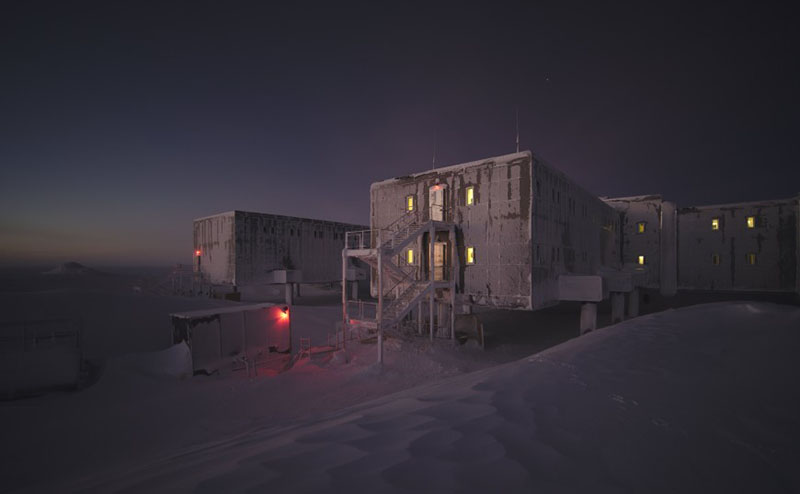
Photo Credit: Raffaela Busse
The elevated station stands out against a thin band of brightening horizon.
After half a year of darkness, the sun rose once again over Amundsen-Scott South Pole Station on September 22. The forty winterovers have been awaiting this moment with great anticipation and relief, only to find themselves inside a big white Ping-Pong ball of blowing snow at the day of the equinox. The inclement weather lasted for several days, so before anybody actually saw the sun, it was already a degree above the horizon - what a bummer!
The kitchen staff compensated with an amazing Sunrise Dinner. Seven courses, cocktails and a gingerbread-station managed to distract the crew from the unfortunate weather conditions.
Though missing the moment of sunrise was a bit of a disappointment, the first two weeks of September leading up to the big moment were exceptionally gorgeous. The dawn painted an orange shimmer to the snow in a world of lavender and purple, and the earliest light of day unveiled all kinds of bizarre but beautiful snow formations that the wind had sculptured in the dark over the course of the last six months, previously unseen by the eyes of the intrepid winterovers.
With good weather usually come extreme temperatures. At the beginning of September, the thermometer dropped to minus 100 degrees Fahrenheit, and it didn't really warm up until the very end of the month.
For the next month, life at pole is going to get even busier. Over the next month, the crews will deep clean the whole station from the tunnels to the roof, the skiway has to be re-groomed and reestablished for the first flights, and the fuel pit has to be set up. With any luck, maybe the winterovers will be rewarded by some fresh fruit that usually arrives on one of the first small aircrafts!
A Neutrino Discovery for “Christmas”
By Raffaela Busse, South Pole correspondent
August 1, 2018
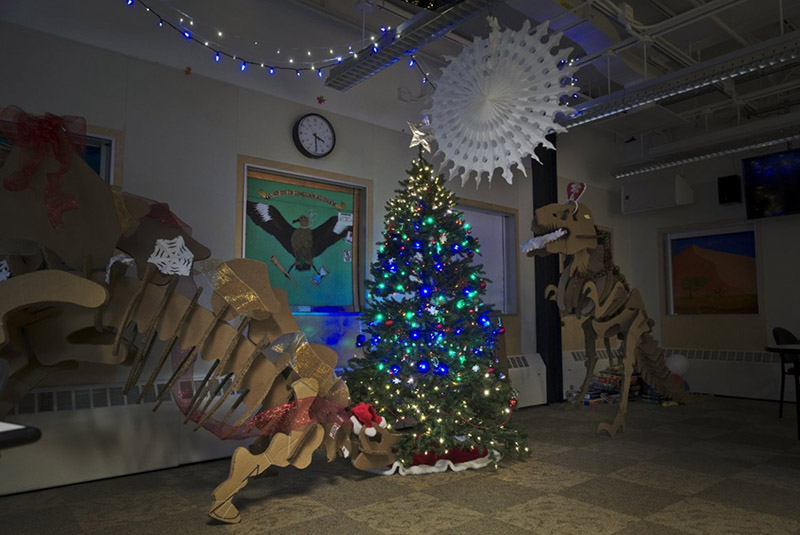
Photo Credit: Raffaela Busse
Alex the stegosaurus and Olivia the T-Rex help the station celebrate Christmas in July.

Photo Credit: Raffaela Busse
Green aurora light up the sky over Amundsen-Scott South Pole Station.

Photo Credit: Raffaela Busse
A lone figure stands out in the Antarctic Winter, watching the aurora shine over the IceCube laboratory.

Photo Credit: Raffaela Busse
The winter crew at the station watch a recording of the NSF press conference announcing the IceCube breakthrough.
The sun hasn't shone over Amundsen-Scott South Pole Station for the past six months. All the while, the seemingly endless desert of ice has been slowly trying to consume Amundsen-Scott South Pole Station, humanity's only refuge within hundreds and hundreds of miles. Snowdrifts as big as the station itself surround the whole building, and the 40 winter crewmembers are working hard to keep the exits free and the staircases accessible. It's going to take much of next summer to free Amundsen-Scott from South Pole's icy grip.
Holidays - and the festivities they come with - are very important to winterovers’ morale. But what to do when Midwinter happened a month ago and there won't be any other major holidays for at least another two? You come up with our own!
Christmas in July is a tradition at South Pole; featuring decorations in the galley, Christmas music, cookies, an amazing turkey dinner, ugly Christmas sweaters and gift exchanges. Even the two cardboard South Pole dinosaurs, Alex and Olivia, were excited to break the daily routine with some holiday flair.
In the otherwise slow and usually uneventful months after Midwinter, the nine grantees can fully dedicate all their time to science. The two IceCube winterovers in particular had a reason to celebrate. The IceCube collaboration and National Science Foundation announced a major breakthrough in multi-messenger astronomy. For the first time, the source of an ultra high-energy neutrino was identified as a supermassive black hole, known as a “blazar,” some 4 billion light years away. It had been detected in September of last year by the IceCube team, who in turn quickly alerted telescopes around the world to observe the region around where the neutrino came from to confirm its origin. This caused a good deal of excitement on station among the scientists as well as the support staff. Many of the winterovers gathered together and watched a recording of the press conference announcing the groundbreaking discovery.
Midwinter Under a Clear Dark Sky
By Raffaela Busse, South Pole correspondent
July 27, 2018
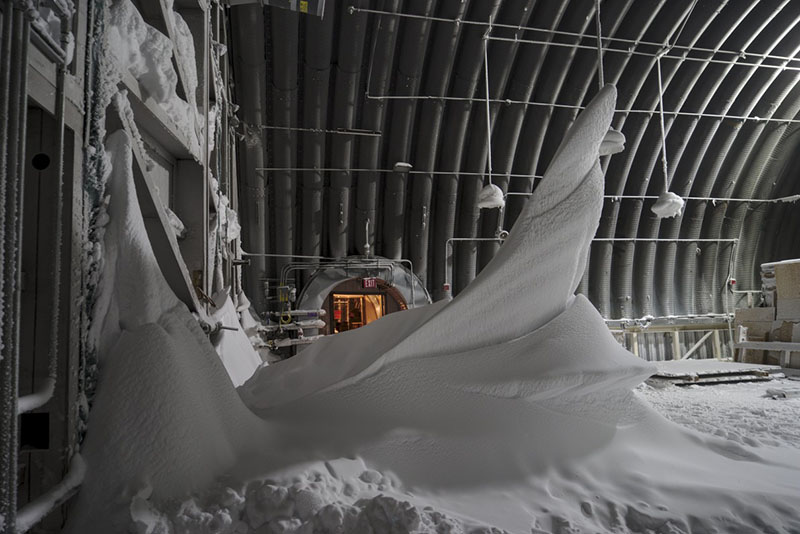
Photo Credit: Raffaela Busse
An almost rock-hard snowdrift, known as a sastrugi, built up one snowflake at a time in the logistics arch.
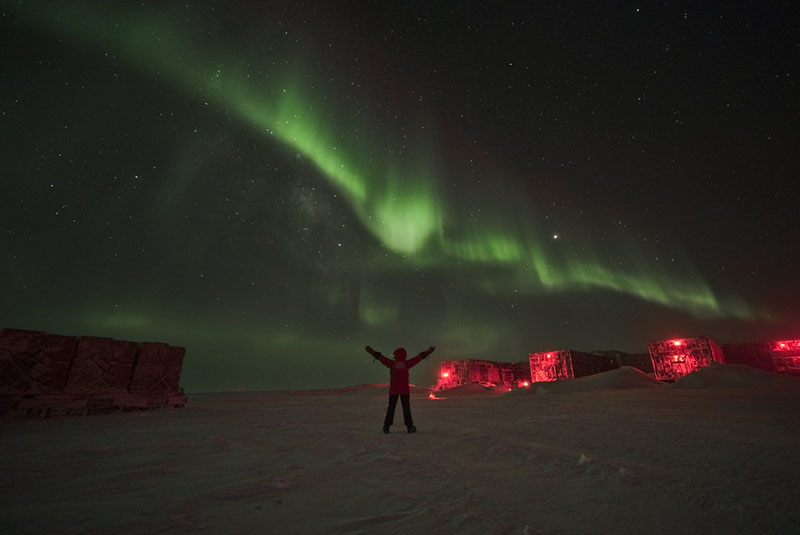
Photo Credit: Raffaela Busse
Clear skies meant dramatic aurora over Amundsen-Scott South Pole Station.

Photo Credit: Johannes Werthebach
The wintering crew pose for the official South Pole Midwinter photo.
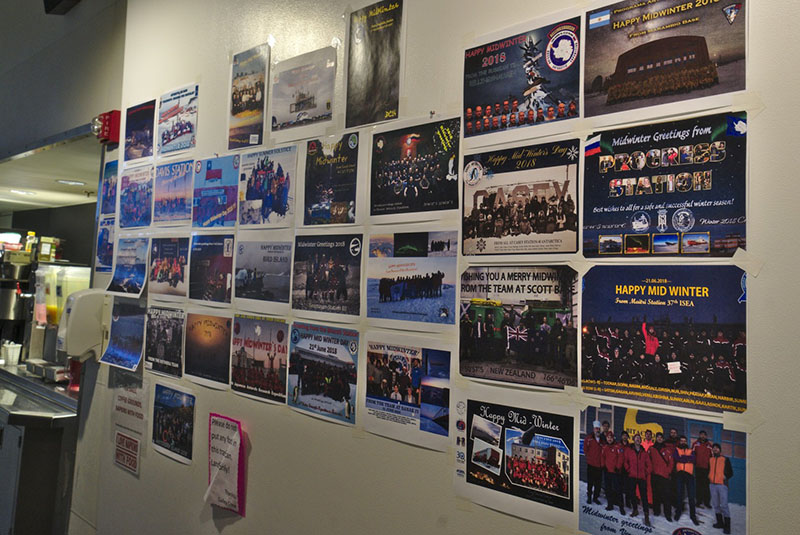
Photo Credit: Raffaela Busse
Midwinter greetings from stations across the continent adorn the wall of the cafeteria.
Happy Midwinter, everyone!
For many of us here at Amundsen-Scott South Pole Station, it feels like the season has just started and the last aircraft departed just a couple of weeks ago. Somehow though, we have already made it halfway through winter.
Midwinter is the winter solstice, when the sun is farthest from the horizon, and roughly the midpoint between the last and first planes of the winter season. It’s the most important holiday here in Antarctica, it has to be celebrated accordingly, with the most amazing Midwinter Dinner imaginable. The feast featured two signature cocktails, a seven-course menu and the ever-popular fake-fireplace on TV. For anyone who packed just one fancy outfit, this was the day for wear it. The winter solstice is also the day to send season’s greetings to all the other stations in Antarctica that are occupied during the cold dark winter. Greetings from 34 stations now adorn the wall of the galley.
Meanwhile, the wintering crew at Amundsen-Scott are recovering from a bad-weather streak that lasted for weeks and broke several wind records for the month of June. The storm pushed a gigantic sastrugi (a snowdrift nearly as hard as concrete) through the closed doors of the logistics arch, one snowflake at a time, over the course of a single weekend. It was pretty to look at, but quite a bit of work to shovel away - just to have another one pushed in a week later. But just in time for midwinter, the weather cleared up and has stayed pretty since. Let's hope the 40 winter crewmembers are blessed with auroras and an amazing night sky for the second half of the season.
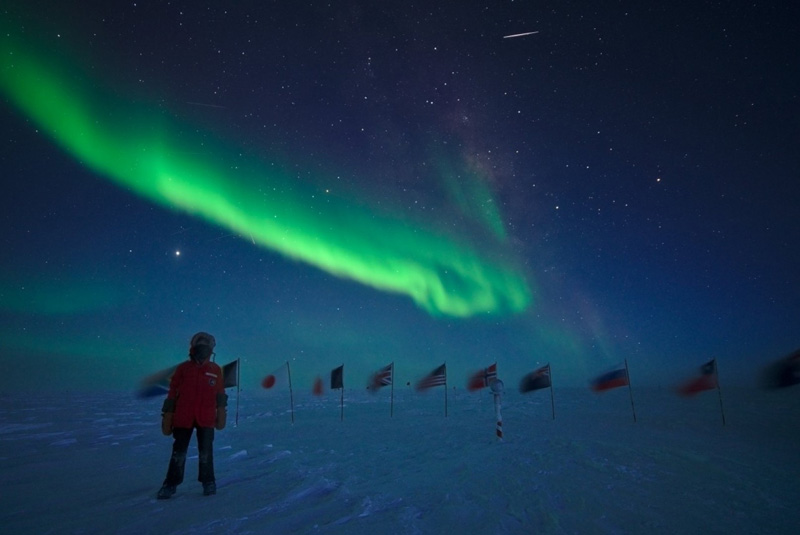
Photo Credit: Raffaela Busse
Green aurorae light up the sky above the ceremonial South Pole.

Photo Credit: Raffaela Busse
Behind a scaffolding tower, a full moon rises over the horizon.
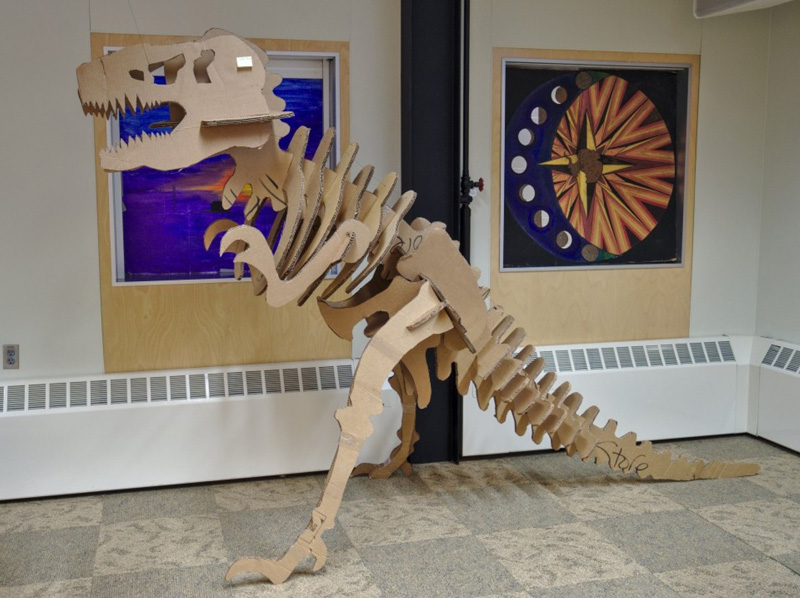
Photo Credit: Raffaela Busse
Using spare pieces of cardboard scrounged around the station, residents built a Tyrannosaurus Rex skeleton.
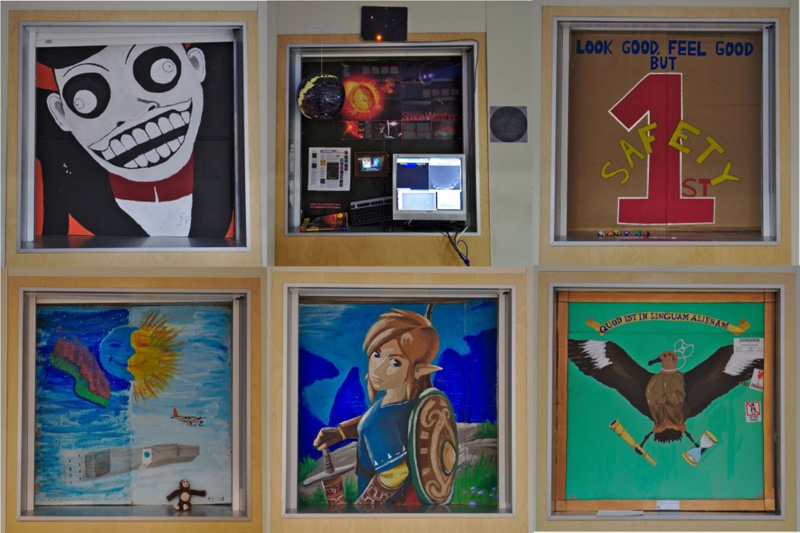
Photo Credit: Raffaela Busse
Windows need to be blocked off with cardboard so light from the station doesn’t interfere with the all-sky aurora cameras. In their off hours, station residents decorated the cardboard to brighten up the inside of the station.
Skies Full of Stars and Aurorae
By Raffaela Busse, South Pole correspondent
May 3, 2018
Aurora season has started at Amundsen-Scott South Pole Station. Although the sun is long gone, its faint radiance still emanates from below the horizon - so that half the sky is lit up by twilight, while the other half is brightened by the dancing lights of the Aurora Australis.
But auroras are not the only magical thing that shines at South Pole's night sky. There's nothing more astounding than the first full moon after sunset, which appears huge down here for some reason. Every day the skies grow darker and the Milky Way's shiny ribbon gets brighter and brighter.
All the magic that happens outside sometimes cannot help the winter crew who are feeling more and more confined inside the station walls - after all, temperatures below minus 90 Fahrenheit aren't uncommon anymore, so people rarely venture outside for recreation. That's why we’ve come up with new ways to keep morale high: Cribbage tournaments, board games, movie nights – some of the crew even built a gigantic Tyrannosaurus Rex skeleton out of cardboard!
On the subject of cardboard: By mid-April, all the station windows have to be covered up with pieces of plywood or cardboard, to keep the light-pollution outside as low as possible. It’s important for science as there are very sensitive cameras on the roof that monitor the aurora activity, and the measurements could be compromised by stray light from the station. But at the same time, it makes all the amateur aurora photographers happy too.
However, because it's lame to stare at plain cardboard for the entire winter, people decorated the window covers. A couple of weeks ago, our station manager organized a window-cover-design-contest No winner has been announced yet, but the competition brought forth some pretty amazing pieces of art.
The Polar Equinox
By Raffaela Busse, South Pole correspondent
April 2, 2018
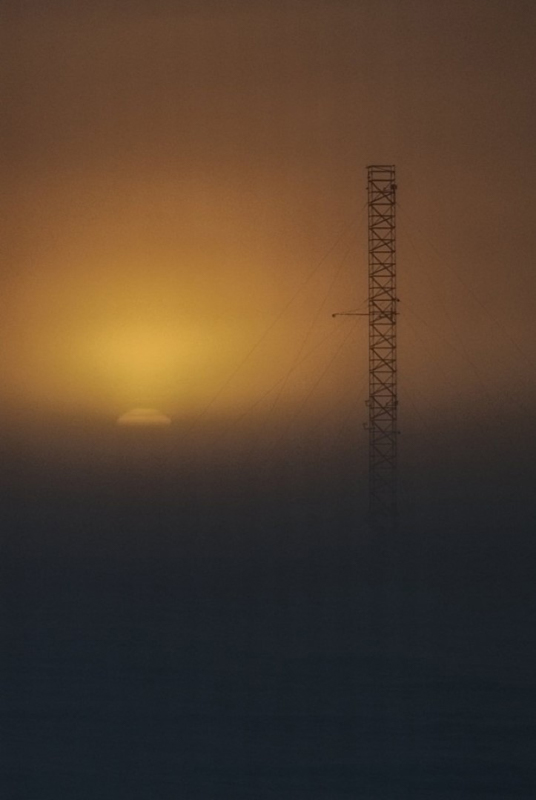
Photo Credit: Raffaela Busse
During a brief window in the stormy skies, the winter crew caught a glimpse of the sun setting below the horizon, marking the onset of six months of night.

Photo Credit: Raffaela Busse
Members of the winter crew mark the beginning of the six-month-long polar night with the traditional Sunset Dinner.
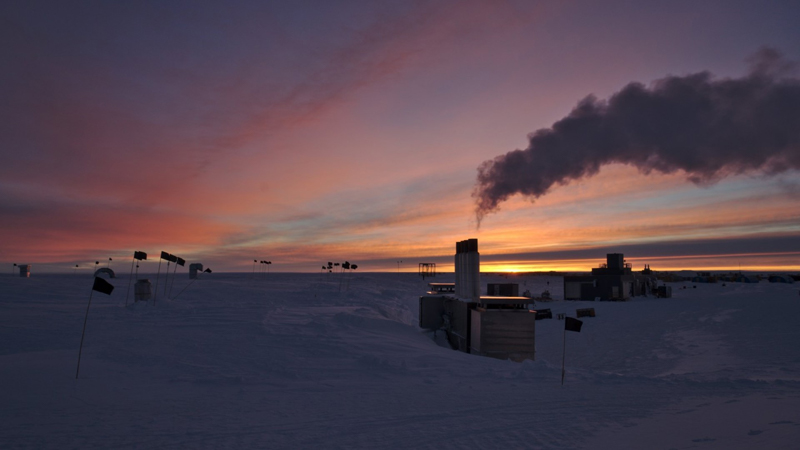
Photo Credit: Raffaela Busse
With steam rising out of the station’s tunnels in the foreground, the sky above the station lights up with a spectacular sunset as twilight gradually gives way to night.
Life at Pole has slowed down quite a bit. All the summer staff have left since last month, and Amundsen-Scott South Pole Station is so quiet now! The winter crew of 40 has settled in to their quarters and set up the station all nice and cozy for the longest night on Earth.
Of course the biggest event of this month was supposed to be the beautiful South Pole sunset - which we almost completely missed, because the weather had other plans. The moment of Equinox on Tuesday, March 20th was clear - but the following days, which are said to be the prettiest, were completely obscured by one of the biggest storms I've seen so far at South Pole. With wind speeds around 30 knots and blowing snow everywhere, there was no chance to even tell the sun's position on the horizon!
But at the point where nearly everyone had given up hope of seeing the sunset, a miracle occurred - the sky cleared up for a few hours and gave the winter crew the chance to witness the most beautiful display of colors. We even got a glance at the "green flash" for a few brief seconds. It’s an optical phenomena caused by the refraction of sunlight in the atmosphere which at the South Pole, in good conditions, can last for several minutes or even hours.
All frustration about a short sunset (for Polar circumstances) was gone immediately upon being seated to the most amazing sunset dinner ever created by a South Pole galley crew. Not five, not six, but a total of seven courses brought a smile to everyone's faces and a warm feeling to everyone's tummies. Here's to a successful winter season! Cheers!
The Last Flights of Summer
By Raffaela Busse, South Pole correspondent
March 6, 2018
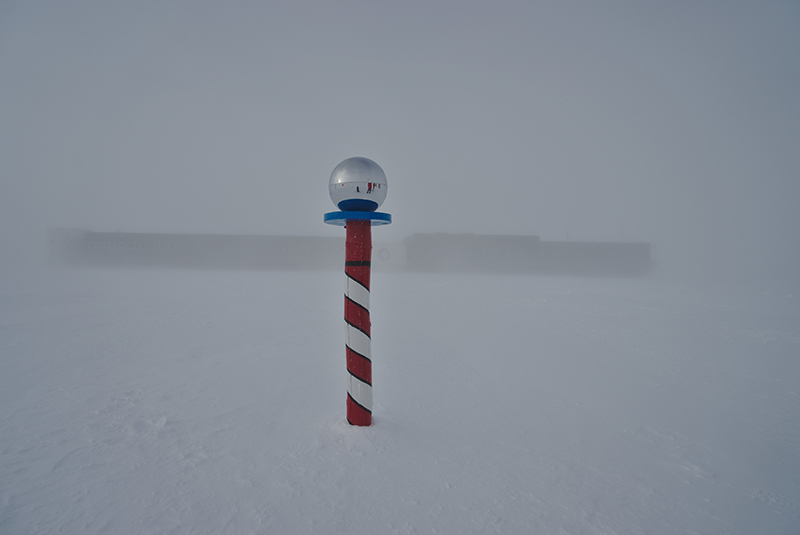
Photo Credit: Raffaela Busse
Whiteout conditions obscure the Amundsen-Scott South Pole station behind the ceremonial pole.

Photo Credit: Ta-Lee Shue
The last of the summer crew leaves Amundsen-Scott South Pole Station on board an LC-130.
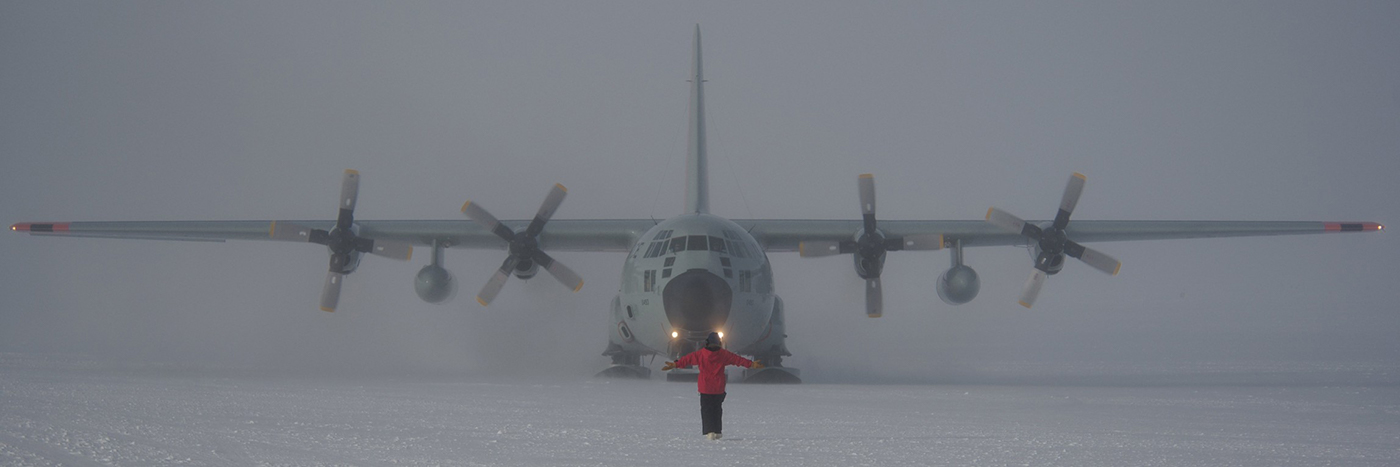
Photo Credit: Johannes Werthebach
A worker at the South Pole marshals a taxiing LC-130 Hercules. After the last flight of the season, no flights will return to the pole for more than eight months.

Photo Credit: Robert Schwarz
The moon blocks out part of the sun during a partial solar eclipse on February 16th.
February is most likely the busiest month at South Pole. Everybody was involved in preparations for--and the aftermath of--the last flight of the summer season. From fuel-pit breakdown to cleaning out empty berthing rooms, the end of summer season is an all-hands job for the Amundsen-Scott South Pole Station population.
From those who work in the fuels department, the end of the summer is. in a way ,a big relief. It means no more flights are arriving at or departing from South Pole Station airfield; no more LC-130s have to be defueled, and no more Twin Otters or Baslers need filling up for their flights to the British Rothera station. All five fuelies spent the majority of their time out on the windy flight deck the week before the last flight, working day and night, up to three tanker flights in a row - and believe me, with wind chills down to minus 100 degrees Fahrenheit, you can tell that winter is coming!
But now that the month is almost over, life at Pole is finally settling down a little. The 40 members of the winter crew are almost done with wrapping up for the long Antarctic night, and are ready to start the "real" adventure. Tradition dictates a movie marathon featuring different iterations of "The Thing" the night after the last Hercules left South Pole. For everybody who is not familiar with John Carpenter's classic: An alien life form lands in Antarctica and starts to kill off the population of a research outpost one by one. Luckily we still have 24 hours of sunlight every day, which keeps the my-fellow-winteroverers-is-possessed-by-alien-parasites-paranoia down a little.
As the sun slowly but noticeably makes its way down towards the horizon, people start to develop routines and methods to keep themselves busy once the craziness is finally over. The gym is booked almost every day, for dodgeball, badminton, Wiffle Ball and the occasional all-hands movie night. There are astronomy classes, board game nights, screen-print sessions - and of course the "Run to McMurdo," a running challenge in which you have to make it all 835 miles from Pole to McMurdo Station, virtually on the treadmill, the rowing machine or the stationary bike. Bets for the fastest athlete are already being taken.
A New Year at Pole
By Tim Ager, South Pole correspondent
February 5, 2018

Photo Credit: Johannes Werthebach
On New year's Day the 2018 Pole marker highlighting the aurora over the station and the continent was unveiled for the first time.

Photo Credit: Hyme Wilkins
Station members line up to pass the U.S. flag to the new pole marker position.

Photo Credit: Hyme Wilkins
This amazing sundog, a phenomenon caused by ice crystals suspended in the atmosphere refracting sunlight, could be seen for about an hour over the station.

Photo Credit: Hyme Wilkins
The six SPoT3 fuel bladders lined up in front of the station, ready to offload much needed fuel.
Station residents welcomed the new year with tradition at the South Pole. The new pole marker designed by the 2017 winter crew was unveiled for the first time at the annual pole marker ceremony held on January 1. The station sits on a nearly two-mile-thick piece of ice that is continuously sliding towards the Weddell Sea at a rate of about ten meters per year, meaning the marker indicating the precise Geographic South Pole needs to be relocated from time to time. Tradition dictates that this relocation occur on New Year’s Day with the unveiling of a new marker each year, designed by the previous year’s wintering crew.
It was a beautiful summer day for the ceremony, and much of the station participated. The U.S. flag was moved from the old pole marker – passed from one person to the next – until it was placed next to the new pole marker. The 2018 winter site manager, Marco Tortonese, spoke briefly about all that the new marker would witness in its upcoming year, and the covering was removed so we all could see it for the first time.
We were all treated to an amazing sundog (or “parhelion” to use the more technical term) display early in January. This phenomenon occurs when sunlight refracts through ice crystals, and produces a halo around the sun along with bright spots on either side. While minor sundogs are quite common at Pole, this one was spectacular. Two halos were clearly visible along with a bright horizontal beam that circled the horizon. We were extremely lucky to witness such an incredible sight.
In “getting ready for winter” news, the third South Pole Overland Traverse (SPoT3) – the last of the three overland traverses – delivered much needed fuel for the station, and are now on their way back to McMurdo. The last LC-130 flights over the final two weeks of the summer season will top off the remaining fuel requirements.
We experienced a couple of weeks of beautiful summer weather in early January, with temperatures soaring to around minus 5 degrees Fahrenheit. But as the sun began to dip from its high point of about 23 degrees above the horizon, so too did the temperatures begin to dip. Now at the end of the month we are averaging about minus 30 Fahrenheit, an indication that the summer season is almost over. Soon the station population will drop by about two-thirds, with the majority of people heading north. The winter-overs will then be left to care for the station over the long dark winter.
Christmas at Pole
By Tim Ager, South Pole correspondent
January 26, 2018
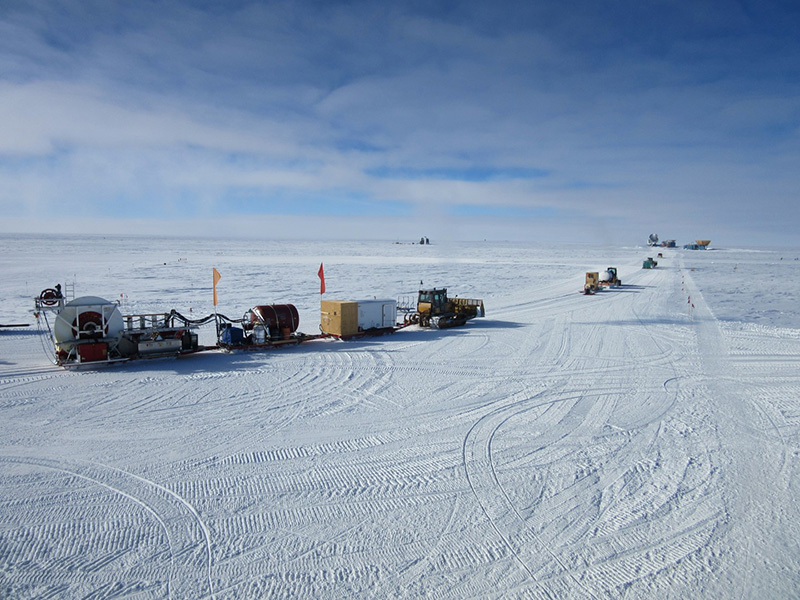
Photo Credit: Leah Street
Tractors pull the Askaryan Radio Array drill rig and supporting equipment to its drill sites.
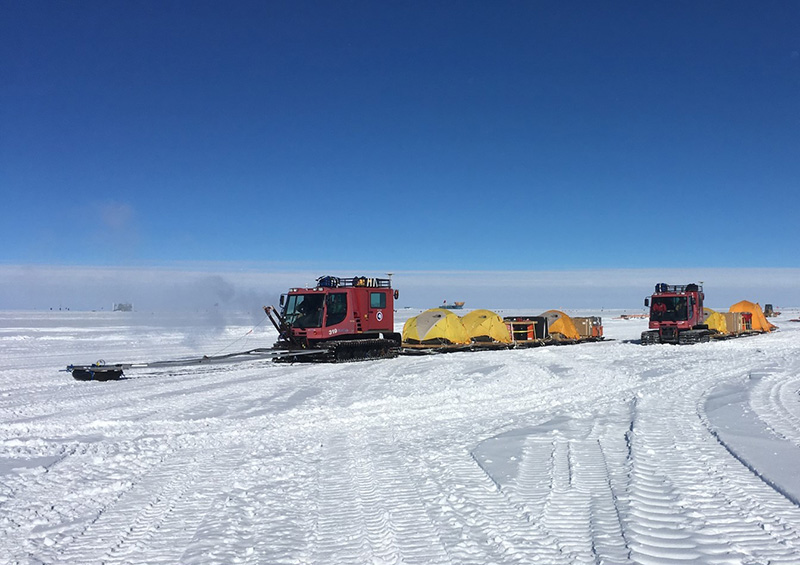
Photo Credit: Tim Ager
The two 88-South Traverse Pisten Bullys pull sleds as the team departs from the station to begin their 750 km journey.
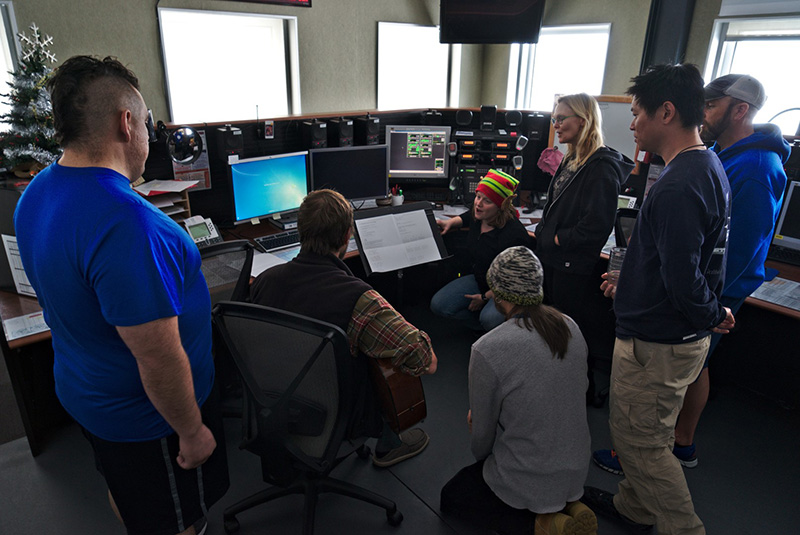
Photo Credit: Raffaela Busse
South Pole residents sing holiday carols over the radio to McMurdo station and field camps.

Photo Credit: Tim Ager
Participants take off at the start of the race around the world, a course that takes participants on a 5 kilometer course around the Geographic South Pole that crosses all time zones.
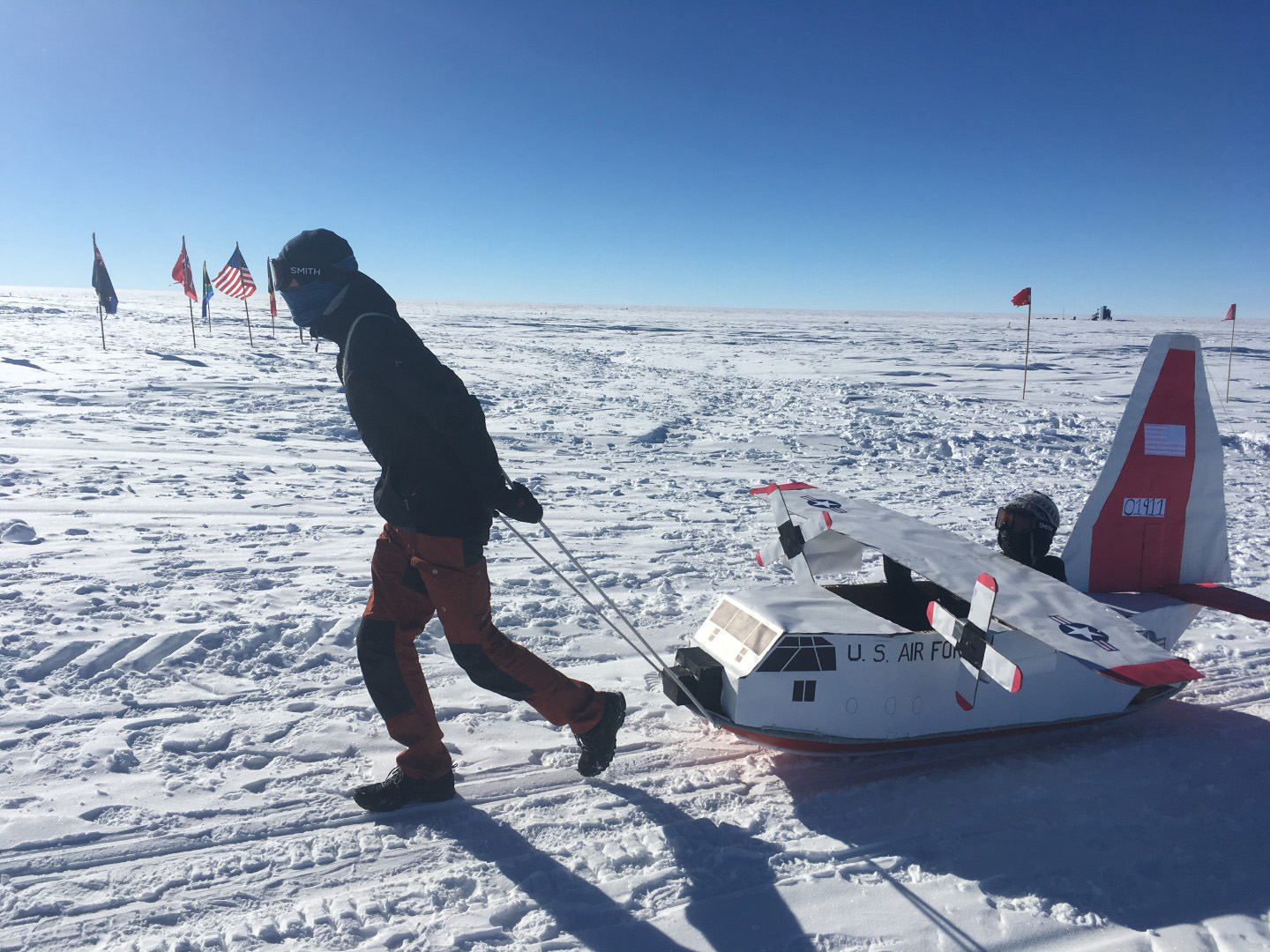
Photo Credit: Tim Ager
One two-person team completed the Race around the World in a particularly creative, but strenuous, way
December was a very busy month at Pole. Because of uncooperative weather, we only received four of our scheduled 14 flights by Thanksgiving. This put us behind on both personnel and cargo, so December became catch-up time. We haven’t quite fully recovered from our slow start, but we are in a much better position now than we were at the beginning of the month.
The first two of three South Pole overland traverses (SPoT1) have reached Pole. SPoT1 and SPoT2 each delivered much needed fuel that will keep the station up and running throughout the long winter. SPoT2 recently departed the station, and we look forward to the arrival of SPoT 3 later in the season.
The development of the Askaryan Radio Array (ARA) is a large project that got underway in December. ARA is designed to detect and measure high-energy neutrinos from space by observing the radio pulses they generate as they travel through the ice. The team will be drilling holes in the ice for placement of the detectors, and it was a big milestone when the drill rig was fully prepped and left for the drill sites.
Another project that got up and running this month is the “88 South Traverse.” This project will conduct a high-precision GPS survey based out of South Pole, around part of the 88-degree line of latitude. It will produce a large-scale dataset for the calibration of airborne and space-borne measurements of the ice sheet, and to validate future ICESat-2 elevation measurements. Their 750-kilometer trek will take between two and three weeks to complete.
Although everyone has been putting in long hours, we were able to take some time off to celebrate the holidays.
The galley crew put together an amazing Christmas meal, which featured lobster tail, duck breast, and beef strip loin along with delicious sides and desserts. Much of what they have to work with was frozen, but they make everything taste fresh. The galley windows were covered to block out the sun, and we all enjoyed a cozy meal complete with a roaring fire displayed on the monitors.
Also, the annual Race around the World was held on Christmas morning. This traditional 2.25-mile race crosses every line of longitude and participants are encouraged to dress in costumes. The most impressive costume was a two-person team that built an LC-130 airplane model on a sled. They took turns riding and pulling, and completed the whole course.
To round out the holidays, McMurdo Station hosted Christmas carols via VHF radio, and several people gathered in the communications room here at Pole to listen to the radio broadcast. Multiple field camps called in to sing, and the Pole participants contributed three songs as well. Although we are all isolated and separated by many miles, it was so nice to listen and share carols with others across the continent. A huge thank-you to McMurdo for hosting the event!
Station News Home Page



































